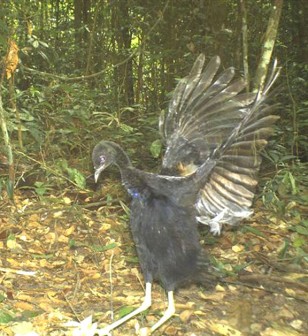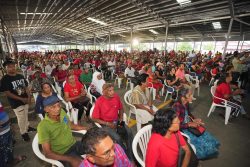The Grey-winged Trumpeter (Psophia crepitans) is distributed north of the Amazon River, in Ecuador, Colombia, south Venezuela, north-east Brazil, north-eastern Peru and the Guianas. Locally the species is known as ‘Waracabra‘ Usually found in dense, humid, mature tropical forests, in Guyana they can be found in all habitats except the savannah and mountains.
In appearance, the male and female are similar. Generally the trumpeter is a guinea fowl-like bird with a long neck and legs, and a short chicken-like beak. These features relate trumpeters to rails and cranes. The neck and head are covered in short plush-like black feathers and the secondary feathers end in a long hair-like filament. The neck base is metallic purple, green and bronze. The rest of the plumage is black, except for the ochraceous feather tips of the lower mantle and grey secondary feathers.
Trumpeters are quite gregarious birds. They are usually found in groups of six to eight members with a permanent territory but sometimes they form groups of up to 100. Trumpeters are weak fliers, flying infrequently which takes considerable effort, but they will perch in trees at night to sleep. If pursued they can run swiftly to escape.They feed during the day on a diet consisting mainly of worms, insects, fruits and young leaves. Locally the flock might migrate due to the seasonal changes, going to higher grounds during the rainy season and moving closer to water sources during the dry season, but it is not known whether they travel long distances at any particular time of the year.
![]() The breeding season is March/April. When mating, Grey-winged Trumpeters are known to have elaborate and noisy courtship displays involving strutting around with their wings spread widely, leaping and even somersaulting in their excitement.
The breeding season is March/April. When mating, Grey-winged Trumpeters are known to have elaborate and noisy courtship displays involving strutting around with their wings spread widely, leaping and even somersaulting in their excitement.

They nest in the hollow of trees approximately 4.6 to 6.1 metres above ground. A nest is not built but the eggs are laid directly on the floor of the hollow. Up to six white eggs are laid and incubated for about 28 days. The eggs are incubated by members of the group.
The mother brings the babies down from the nest about one week after they are hatched. The chicks have elaborately patterned downfeathers, coloured blackish with streaks and bars of cinnamon and rufous.
The Grey-winged Trumpeter is hunted but not trapped locally. The population of this bird has decreased especially around the communities. They are listed as ‘least concern’ by IUCN within its range. They are sometimes kept as pets by local people as they are known for their prowess in killing or keeping snakes away. They are also good ‘watch dogs’ and would give a sign or signal when strangers are around.
Rain forests are rich in biodiversity and are home to many different plants and animals. In addition, indigenous communities make their homes there. Even if you don’t live in the rain forest, humans rely on the forest for resources such as building materials (wood and lianas), medicine and fruits. Rain forests also provide essential environmental services for life on earth; they create soil as well as prevent soil erosion, produce oxygen though photosynthesis, maintain clean water systems, and are a key defence against climate change.
The Iwokrama Rain Forest is 371,000 hectares, located in the heart of Guyana. Our mission is to develop strategies for conservation and sustainable development for local people in Guyana and the world at large. We are involved in tourism, training, research and our timber is certified by the Forest Stewardship Council. Come and visit us in the rain forest or at http://www.iwokrama.org.










